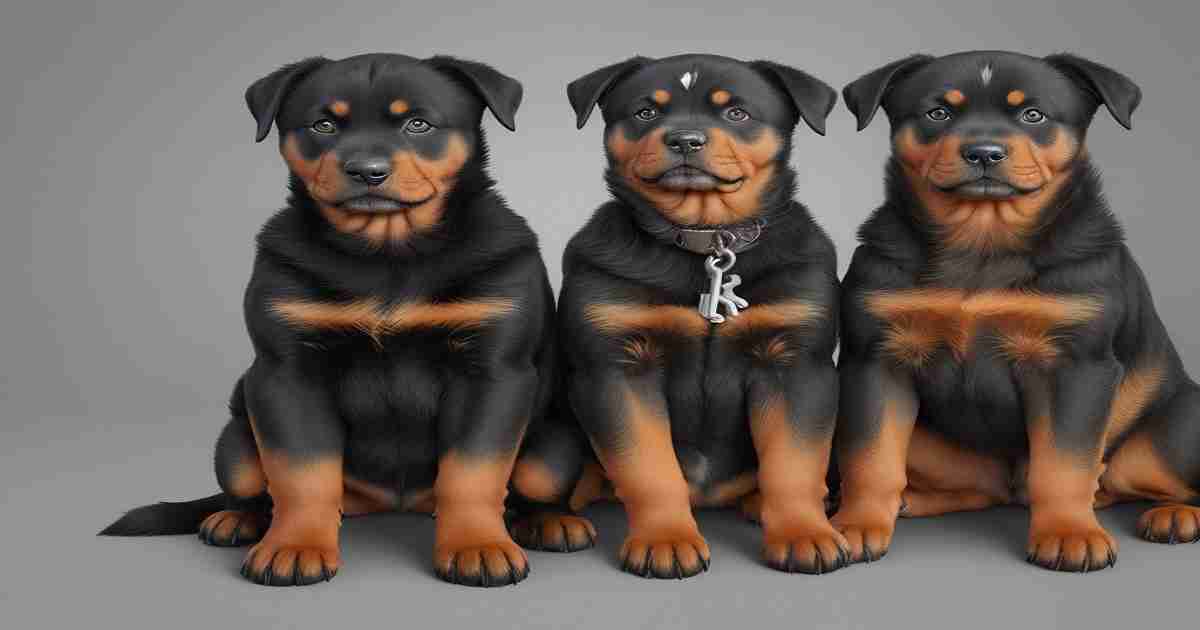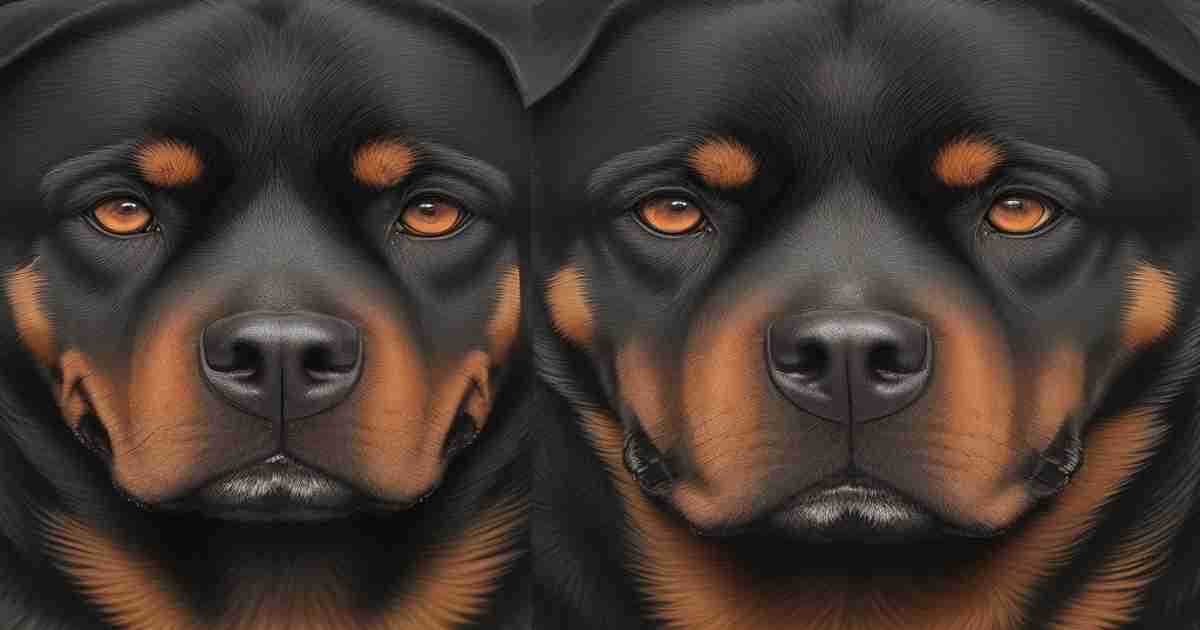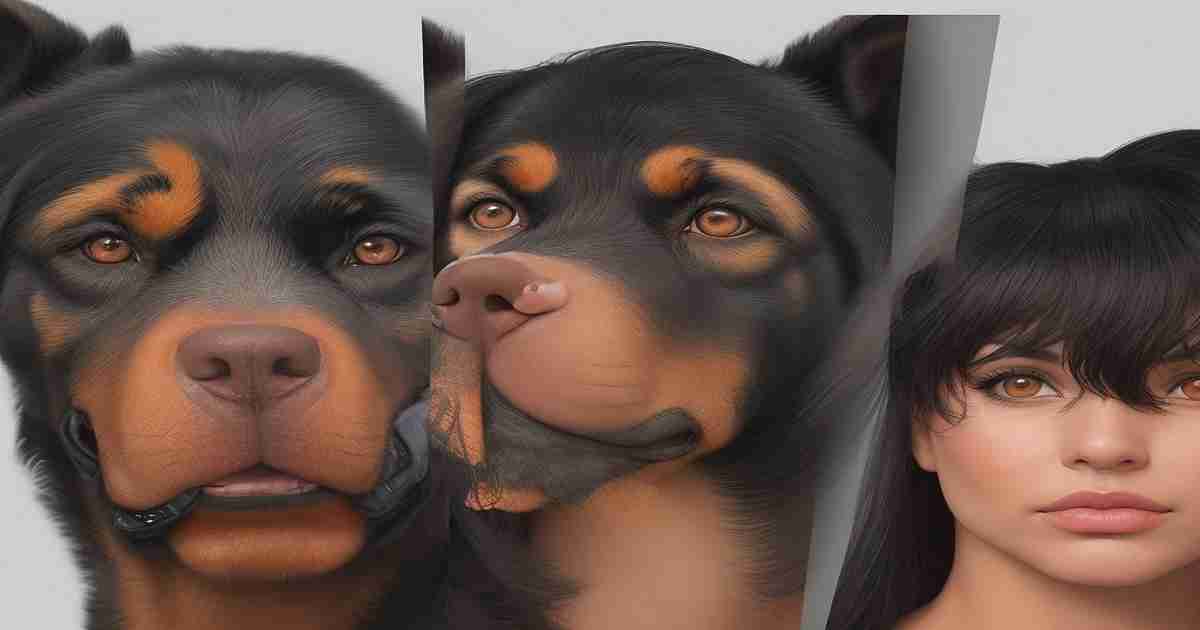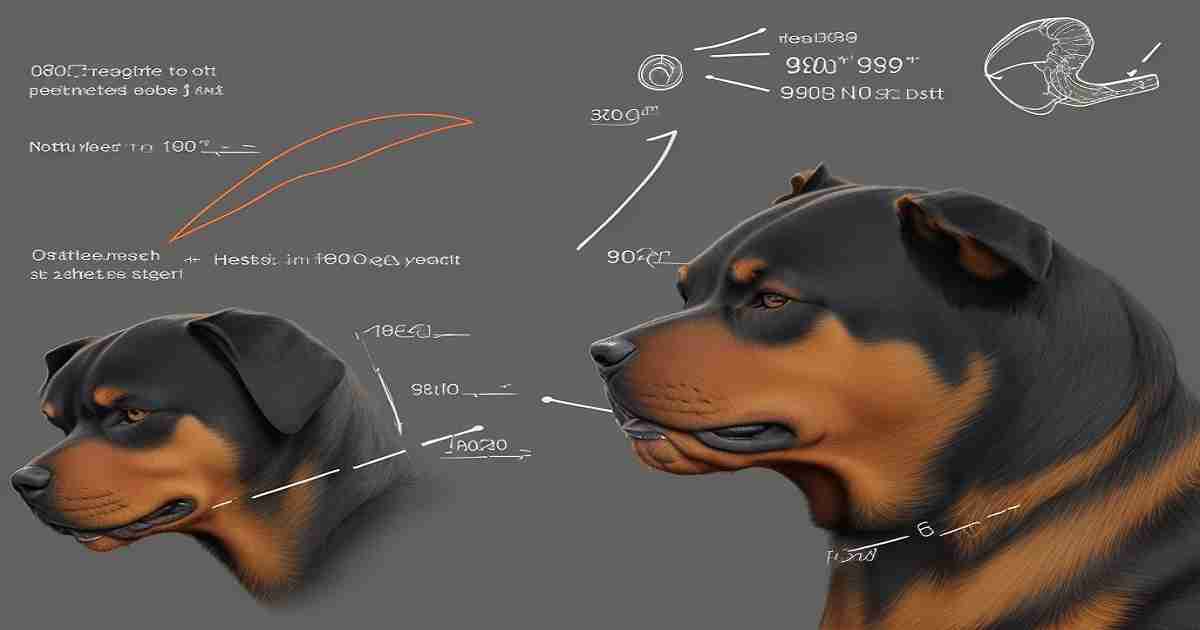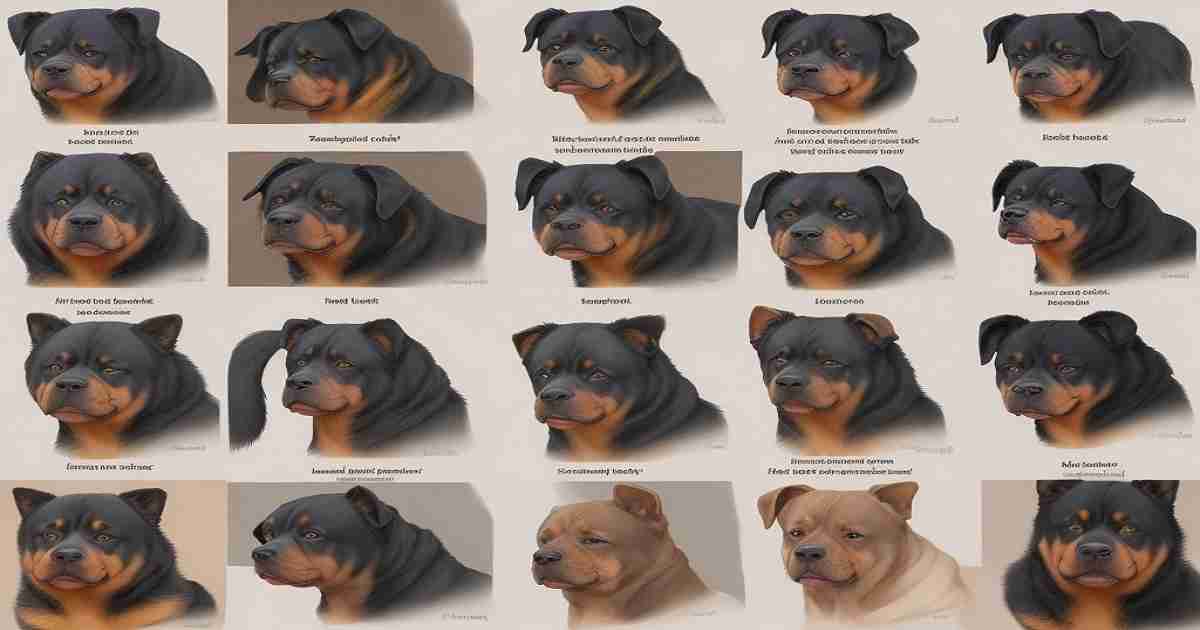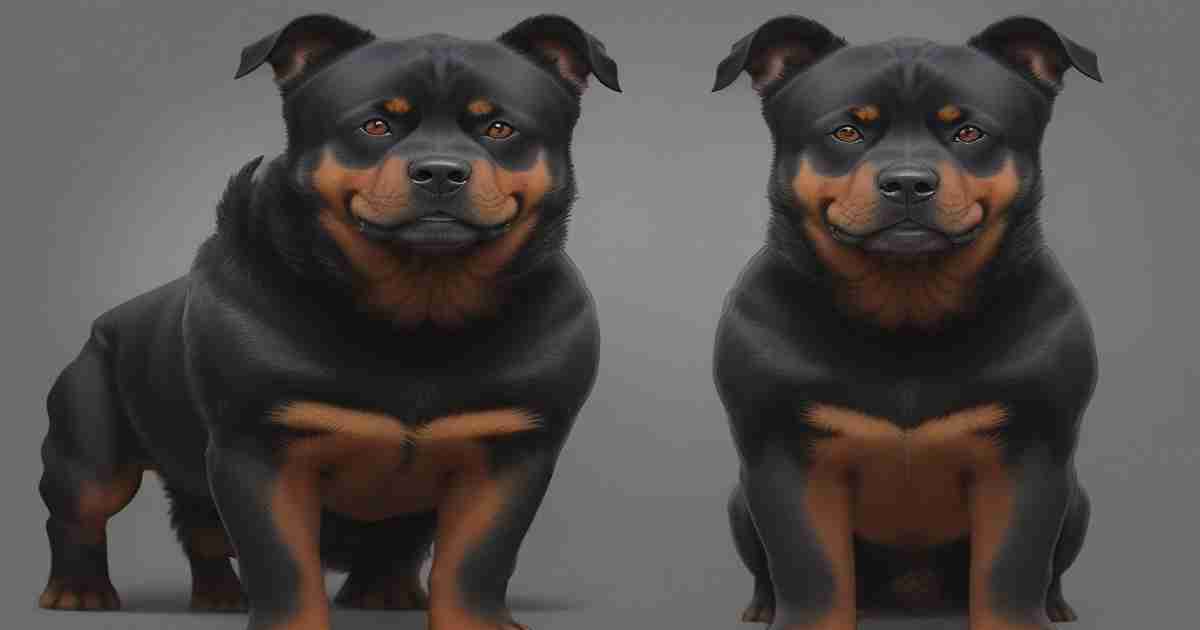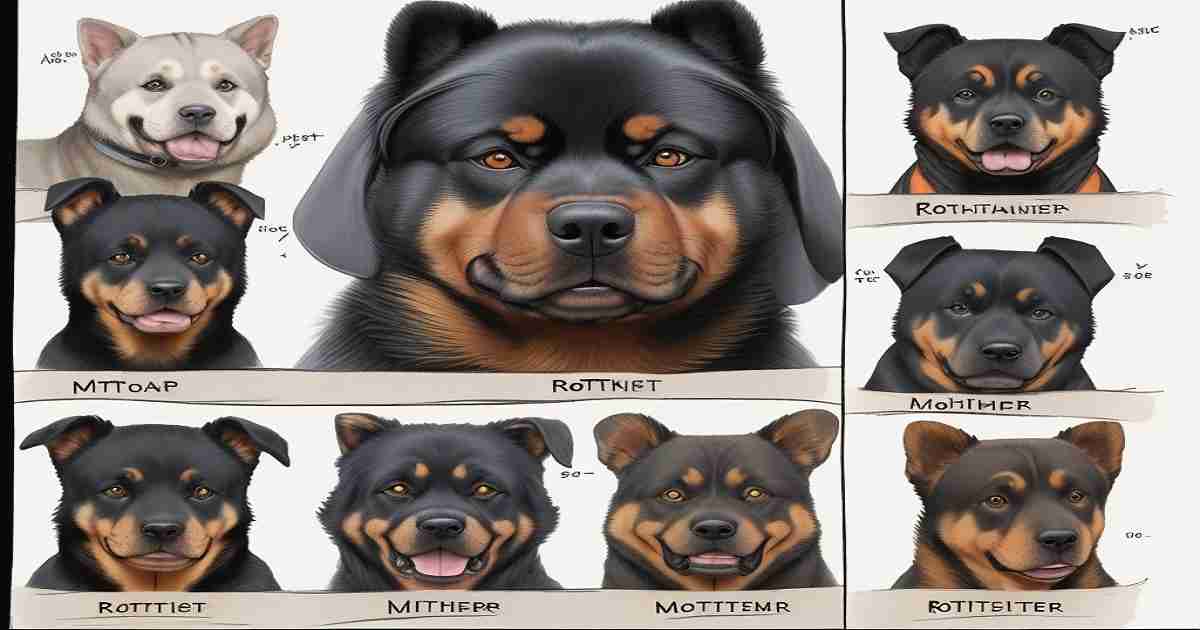As a lifelong Rottweiler owner and breed enthusiast, I was delighted to see these magnificent dogs with all kinds of facial features.
From the preferred standard look to Roman noses and snippy faces, the diversity of Rottweiler appearances is truly fascinating!
This post explores the ins and outs of the various Rottweiler face types. You’ll learn how to identify each one, understand their origins, and get tips for health and care.
Whether you’re looking to adopt a Rottie pup or to boost your breed knowledge, you’ll find all the details here. Let’s dive in!
A Brief History of the Rottweiler Breed
Before we get into the specifics of their faces, it helps to understand where Rottweilers come from.
These hardworking pups originated as drover dogs in the Roman Empire. They marched alongside Roman legions, driving cattle to feed the soldiers.
When the Romans reached what is now Germany, some of the dogs were left behind. Here, they were used by butchers to drive cattle to the marketplace.
The dogs became known as “Rottweil’s dogs” after the town they worked in.
By the 1900s, Rottweilers were bred as police, service, and guide dogs. This versatile breed was recognized by the American Kennel Club in 1931
.The ideal Rottweiler developed as a sturdy working dog – and the standard head and face shape emerged from those functional origins.
Overview of Rottweiler Face Types
When you picture a Rottweiler, you probably imagine the classic black and tan dog with a broad head. But in reality, Rottweiler faces can vary quite a bit!
Here’s a quick rundown of the most common types:
- Standard face: The ideal head, according to the breed standard, with a broad skull, defined stop, strong muzzle, and dark oval eyes.
- Roman nose: A convex nasal bone causing a downward curve, giving a “Roman nose” look.
- Snipey face: A narrow skull and excessive stop create a pointy “snippy” look.
- Faulty faces: Issues like excessive wrinkles, loose flies, or lack of pigment are faults.
The origins and specifics of each face shape are essential for Rottie owners or potential buyers to understand. So let’s explore each of these types in greater detail.
The Ideal Standard Rottweiler Face
The standard or preferred Rottweiler head is defined by the American Kennel Club breed standard. It describes the ideal look that breeders aim to achieve.
Characteristics of the Standard Head
So what are the key features of the standard Rottweiler head?
- Broad skull: The skull is moderately wide between the ears. It should appear very square from the front and sides.
- Defined stop: There is a pronounced but not exaggerated stop or indentation between the eyes at the brow.
- Strong muzzle: The muzzle is broad with thick, full cheeks. The length from the stop to the nose should equal the distance from the visit to the occiput (back of the skull).
- Powerful jaws: The jaws should be powerful with a scissors bite. The flies (upper lips) are moderately deep and fit close to the jaw.
- Dark oval eyes: The eyes are almond-shaped, moderately deep-set, and dark brown. They convey an alert, intelligent expression.
- Triangular ears: The ears are rounded at the tips and set high on the head. They stand forward close to the cheek.
- Confident expression: A Rottweiler’s face should denote confidence, nobility, and courage.
The broad skull, defined stop, and strong muzzle create the ideal Rottweiler face.
This combination of features allows the Rottweiler to breathe easily, even while working or performing roles like search and rescue.
In cold weather, the large nasal cavity warms air before it reaches the lungs. And the strong jaws allow for carrying large objects. Form follows function in this powerfully built head.
“I prefer the classic Rottweiler head as it was intended by the breed’s founders,” says AKC judge Amanda Smith.
“This face shape allows Rottweilers to work as the rugged, versatile dogs they are meant to be.”
Why the Standard Look Matters
So why is it essential for Rottweilers to adhere to the standard head type?
- Health: Dogs with very narrow or short muzzles can have trouble breathing, overheating, and may require airway surgery. The standard head allows for healthy respiration.
- Functionality: As working dogs, standard Rottweiler heads allow a strong bite, carry large objects, and stay cool in hot/cold weather.
- Breed purity: Following the standard maintains the original breed type and prevents exaggerations in any direction.
- Reputation: Poorly-bred Rottweilers have contributed to the breed’s bad reputation. Well-bred standard Rotties can help counter that.
For all these reasons, reputable Rottweiler breeders aim to produce dogs with the ideal standard head and face.
It’s not about looks alone – it’s about the whole functional, healthy dog.
When Rotties Take a Roman Nose Turn
Another type of Rottweiler face you may encounter is the Roman nose. Instead of a straight nasal bone, these pups have a convex or downward-curving bridge of the muzzle.
What Causes the Roman Nose?
This distinctive feature occurs due to a lack of a stop on the nasal bone. Usually, the Rottweiler muzzle has a defined finish, giving it a square look from all angles.
With a Roman nose, the muzzle flows in a curve rather than forming an angle between the eyes and nose. The nasal bone bows forward instead of flattening.
While some Roman-nosed dogs are born that way, poor breeding practices can also contribute.
Some unethical breeders selectively breed dogs with missing stops to produce the curved Roman profile.
Potential Problems with Roman Noses
So what are the potential issues with a Roman nose on a Rottweiler?
- Breathing issues: The curved nose can obstruct air flow, leading to difficulty breathing, snoring, etc.
- Overheating: Without proper airflow, Roman-nosed dogs are prone to overheating.
- Eye damage: The curved nasal bone provides less protection for the eyes.
- Teeth misalignment: Jaws may not align properly, causing teeth and bite issues.
- Injury prone: The nose lacks strength and is more prone to breakage.
Unfortunately, some breeders specifically want the Roman nose look, despite potential health problems.
“Reputable breeders avoid breeding dogs with this facial structure, as function should always come first,” advises vet Dr. Stephanie Richards.
A Roman nose on a Rottweiler occurs due to a lack of stop on the muzzle.
Caring for a Roman-Nosed Rottweiler
Not all dogs with a Roman profile will have issues, but owners should be vigilant. If you have a Roman-nosed Rottie, take these steps:
- Visit your vet for a thorough evaluation of your nose, eye, teeth, and jaw.
- Monitor your breathing, especially during hot weather or exercise.
- Avoid overexertion or activities that may injure the nose.
- Use a harness rather than a collar to reduce injury risk.
- Watch for facial rubbing that could indicate irritation.
With close supervision and veterinary guidance, Roman-nosed Rottweilers can still live happy, healthy lives as cherished companions. Proper care is critical!
When Rottweilers Get Snipey: The Narrow Skulled Face
At the opposite end of the spectrum from the Roman nose is the “sniper” or pointed facial profile. This occurs when a Rottweiler has a long, narrow head and excessive stop.
What Causes a Snipey Face?
A few factors can cause a snipe face in Rottweilers:
- Narrow skull: The skull is fragile, resulting in a very slender, wedge-shaped head when viewed from above.
- Over-angulation: Too much of an angle or stop between the nose and forehead makes the muzzle look pinched.
- Poor breeding: Some breeders may select dogs with more “fox-like” narrow faces, leading to this exaggerated trait.
Potential Issues with Snipey Faces
The sniper’s facial structure also poses some health considerations:
- Tooth alignment: With narrower jaws, teeth are more likely to crowd or misalign.
- Eye injuries: The pronounced stop provides less protection for the eyes.
- Sinus issues: Drainage is poorer in the narrowed sinus cavity.
- Chewing difficulties: Narrow jaws make chewing large bites more difficult.
- Increased barking: Snipey dogs often bark excessively due to their inadequate scenting ability.
“A Rottweiler’s face shape should complement their breed purpose as a working dog,” notes breeder Kim Wilson.
“Exaggerated snippy faces are, unfortunately, another fad in the show ring.”
A sniper’s face is characterized by an excessively narrow skull and pointed profile.
Caring for a Snipey-Faced Rottweiler
If your Rottweiler does have a sniper’s face, be proactive with the following care measures:
- Monitor teeth alignment and remove baby teeth promptly.
- Use eye protection when playing sports or doing search work.
- Keep facial wrinkles clean to prevent skin fold dermatitis.
- Slow down your chewing to avoid choking or vomiting.
- Provide mental stimulation with toys to decrease nuisance barking.
With some adjustments, snippy Rottweilers can thrive as fabulous companions. As an owner, ensure you support your pup’s unique needs.
Common Faults in Rottweiler Faces
Aside from the Roman nose and snippy face extremes, a few other faults may appear in a Rottie’s mug. Here are some to look out for:
Excessive wrinkles: Some forehead wrinkling is normal, but wrinkles should not be prominent or cover the entire face.
Loose flies: Flews should fit close to the jaw. Open, pendulous flies are considered a fault.
Too much or too little stop: The stop should be definite but not overdone. Too little stopping results in a Roman nose.
Light eyes: Rottweiler eyes should be dark brown. Watery eyes are undesirable.
Poor pigment: A lack of black on eyelids, lips, or nose is faulty. These areas should be solid black.
Over or undershot bite: Jaws should close with upper teeth closely overlapping lower teeth in a scissors bite.
Reputable breeders work diligently to avoid these facial flaws through selective breeding and health testing. If you see any of these indicators, ask the breeder about their practices.
How Face Shape Impacts Health in Rottweilers
A dog’s facial structure goes hand-in-hand with its overall health – and Rottweilers are no exception. Here’s how their face shape can influence wellness.
Breathing Issues
Both Roman noses and extremely short muzzles impact airflow and predispose dogs to:
- Brachycephalic syndrome: Difficulty breathing, noisy respiration, overheating, and exercise intolerance.
- Sleep apnea: Interrupted breathing during sleep, lethargy, and behaviour changes.
- Pneumonia: Recurrent respiratory infections.
- Emergency surgery: Such as nostril widening or elongated soft palate correction.
Standard Rottweiler faces with open nostrils and long muzzles have the best odds of avoiding these problems.
Eye Injuries
Rottweilers with either Roman noses or snippy faces have less frontal bone protection over the eyes. They’re more prone to:
- Proptosis: The eyeball popping out of the socket due to trauma.
- Corneal damage: Scratches or ulcers on the eye’s transparent outer layer.
- Foreign objects: Increased risk of dirt, seeds, and sticks entering and scratching the eye.
The prominent brow of a standard Rottweiler head shields the eyes from harm’s way.
Dental Disease
Short or narrow jaws often lead to:
- Malocclusion: Misaligned teeth and improper bite.
- Tooth crowding: Crooked, overlapping teeth that are hard to keep clean.
- Periodontal disease: Gum and bone infection around the teeth.
The standard Rottweiler skull with its large jaws provides ample room for full dentition—42 teeth! This allows teeth to align correctly and makes it easier to keep teeth clean.
Skin Fold Infections
Deep facial wrinkles demand extra care to avoid:
- Dermatitis: Irritated, infected skin with wrinkles.
- Mucus buildup: Accumulation of mucus and debris in facial folds.
- Yeast infections: Chronically infected wrinkles.
- Mites: Microscopic mites that thrive in damp, infected wrinkles.
The standard Rottweiler face has minimal wrinkling, significantly reducing the risk of painful skin fold dermatitis.
Puppy wrinkles are cute, but profound wrinkles in adult dogs require diligent facial care.
In every aspect, the standard Rottweiler skull and muzzle shape provides the best functionality and health. Form follows function with the well-bred Rottweiler face!
“I only breed to the standard outlined by the American and international Rottweiler breed clubs,” says ethical breeder Anne Smith. “It’s so important not to chase fads or exaggerate features to the dog’s detriment.”
Tips for Evaluating Rottweiler Faces
When looking for a well-bred Rottweiler, you must pay close attention to the dog’s facial structure. Here are things to look for:
Head from Above: When viewed from above, the skull should appear broad and square-shaped between the ears. Avoid dogs with extremely wide or narrow heads.
Stop: Look for a defined but not overdone stop between the eyes. It shouldn’t be too deep or too shallow.
Muzzle: The muzzle should not curve upwards or downwards. It should be straight in profile.
Flews: Flews should fit close to the jaw, not hang loose or be overly tight. You should see some flies but not lots of extra skin.
Bite: Check that the upper teeth overlap the lower teeth when the mouth is closed. No undershot or overshot jaws.
Eyes: Eyes should be moderately deep set and oval-shaped. They shouldn’t bulge or have a “hound dog” sad look.
Nostrils: Nostrils should be large and open rather than pinched. They shouldn’t be pulled upward.
Pigment: Look for a complete black stain on the lips, nose leather, and eyelids with no pink showing.
Wrinkles: Some forehead wrinkling when alert is standard, but wrinkles shouldn’t obscure the eyes.
Taking the time to closely assess these facial features will help you choose the healthiest possible Rottweiler with the ideal face shape.
Questions to Ask Rottweiler Breeders About Faces
When interviewing breeders, ask plenty of questions about the parents’ facial features. Here are some key queries:
- Do both parents have standard Rottweiler face types?
- Have the parents been screened for brachycephalic syndrome?
- What is the prevalence of Roman noses or snippy faces in your breeding lines?
- When breeding, do you pay attention to muzzle length, stop, and nostrils?
- Do any of your dogs require airway surgery or other facial corrections?
- How often do you produce puppies with facial flaws? How do you handle that?
- Can I see photos of the parents’ profiles, both head-on and from above?
The breeder’s responses will give you insight into how carefully they select breeding dogs for health and functionality. Be very wary of anyone who intentionally produces extremes.
“I love educating potential Rottweiler homes on the breed standard and health testing,” says reputable breeder Kim Novak. “Asking lots of questions ensures we share the same goals!”
Keeping Your Rottie’s Face Fit and Functional
Caring for your Rottweiler’s face involves more than just keeping it handsome or pretty. Proper care promotes health and a longer lifespan. Be diligent about:
Cleaning wrinkles: Gently clean deep facial wrinkles daily using a damp washcloth. Dry thoroughly after baths.
Brushing teeth: Brush teeth regularly with a dog-safe toothpaste and watch for plaque.
Conclusion
Regarding Rottweiler faces, the function should be the top priority. This working breed evolved the ideal standard face shape to enable maximum performance.
While variations like the Roman nose and snippy face occur, reputable breeders carefully select dogs that adhere to the breed standard.
Not only for looks but, more importantly, for the health and welfare of Rottweiler puppies.
As a prospective owner, closely inspect the parents’ facial features. Ask breeders plenty of questions to ensure their priorities align with yours.
Look for Rottweilers bred to the standard by someone who understands the breed’s history and purpose.
With the right breeder and proper care, your Rottie will have a vigorous, functional face shape that provides long-lasting health and happiness.
That broad skull, defined stop, strong muzzle, and powerful jaws equip the Rottweiler for the working life they love.
FAQs
Q: What is the most common facial flaw in Rottweilers?
A: The Roman nose is one of the most common facial flaws seen in Rottweilers. This happens when the nasal bone curves downward due to a lack of stop. The Roman profile can cause breathing issues but does not meet the breed standard.
Q: Are wrinkly Rottweiler faces prone to more health problems?
A: Yes, excessively wrinkly Rottweiler faces are more prone to skin fold infections, dermatitis, and irritation. The folds trap moisture, dirt, and debris. Standard Rottweilers should have only moderate wrinkles.
Q: Why do some Rottweilers have pointy, snippy faces?
A: A snippy or pointy face occurs when the skull is excessively narrow. This leads to an exaggerated stop and a very slender, wedge-shaped head. It’s considered a flaw and can cause teeth crowding.
Q: How can I find a Rottweiler puppy with an excellent standard face?
A: Thoroughly research breeders, ask about parent dogs’ faces, and visit the facility. Reputable breeders focus on breeding to the standard for health. Review photos of parents for broad skulls, defined stops, etc.
Q: Do Rottweilers with atypical faces make good pets?
A: Rottweilers with some facial flaws can still be beautiful pets! Owners should understand potential health risks and discuss them with their vet. Providing extra care is vital. But their loving temperament remains the same.
